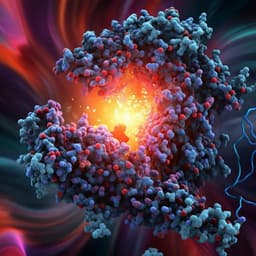
Engineering and Technology
Fast encirclement of an exceptional point for highly efficient and compact chiral mode converters
X. Shu, A. Li, et al.
Discover how recent research by Xiaoqian Shu and colleagues reveals the potential of fast parametric evolution in non-Hermitian systems to create highly efficient and compact asymmetric mode converters, achieving near-unity transmission efficiency for chiral mode switching.
~3 min • Beginner • English
Introduction
Non-Hermitian systems obeying parity-time symmetry exhibit exceptional points where eigenvalues and eigenstates coalesce, giving rise to rich topological phenomena. Photonic implementations with tailored gain/loss in microcavities, coupled waveguides, gratings, and photonic crystals have enabled exploration of EP physics, revealing effects such as loss-induced transmission enhancement, enhanced sensitivity, unidirectional invisibility, and single-mode lasing. Dynamically encircling EPs has been shown to yield chiral state evolution and asymmetric mode switching: the output depends on the encircling direction and can become input-independent. However, conventional continuous encircling loops near EPs suffer from low efficiency due to strong dissipation near EPs; the best reported experimental efficiency is 46%. A Hamiltonian-hopping, discontinuous encircling protocol has been proposed to improve efficiency, but it introduces additional mode crosstalk due to mode mismatch. To overcome these limitations, the authors propose fast and adiabatic parametric evolution along the Hamiltonian parameter space boundary, where eigenstate evolution rates are minimal and at least one eigenstate experiences ultra-low loss. This approach promises compact, high-efficiency asymmetric mode converters and is mapped to a double-coupled silicon waveguide platform for experimental demonstration.
Literature Review
Prior demonstrations of EP encircling in photonics include microcavities, coupled waveguides, gratings, and photonic crystals, enabling asymmetric mode switching and directional responses. Continuous loops near EPs require slow evolution to maintain adiabaticity and inevitably incur high loss, resulting in low chiral transmission efficiency (e.g., 46% maximum reported). Discontinuous encircling via Hamiltonian hopping theoretically achieves higher efficiency by exploiting eigenstate convergence at parameter-space infinities, but practical implementations suffer from additional mode crosstalk due to mode mismatch. Comparisons across platforms (Table 1) show previous devices often require long interaction lengths (mm to meters) and exhibit modest crosstalk (−7 to −13 dB) and limited efficiency; a prior compact silicon implementation achieved 0.46 efficiency and −10 dB crosstalk over 69 µm. The present work seeks to improve both efficiency and compactness by incorporating parameter space boundaries into the encircling loop, enabling fast yet adiabatic evolution and reduced dissipation.
Methodology
Theory: The system is modeled by the evolution equation dψ/dz = i H ψ with ψ(z) = [a1(z), a2(z)], where H(z) = [[β(z) + 2iγ(z), κ(z)]; [κ(z), −β(z)]]. Here β, γ, κ are detuning, loss rate, and coupling strength, respectively, and z is propagation distance. Eigenvalues are E = iγ ± sqrt((β + iγ)^2 + κ^2) with normalized eigenstates X = [sqrt(1 ± M), ±sqrt(1 ∓ M)], M = (β + iγ)/sqrt((β + iγ)^2 + κ^2). The system exhibits an EP at (β/κ, γ/κ) = (0, 1). The imaginary parts of eigenvalues determine amplitude evolution; Im(E1) vanishes along the parameter-space boundary (β/κ or γ/κ → ±∞ with the other finite), yielding a nearly lossless eigenstate X1 there, while X2 loss scales with γ/κ. Adiabaticity: The degree of adiabaticity is quantified by U = |X_m^† (dX_m'/dt)| / (E_m − E_m'), with dr = κ dz and evolution along s-direction in parameter space giving U = dξ/dr, ξ = |X_m^† (dX_m'/ds)| / (E_m − E_m'). Near EPs ξ grows large (requiring slow evolution), while near boundaries ξ approaches zero, permitting fast evolution without violating adiabaticity. Device concept: Encircling loops that include the parameter-space boundary enable fast evolution with minimal loss for one eigenstate, yielding high-efficiency chiral mode conversion with compact footprint. Numerical simulations: Full-wave finite-difference time-domain simulations model TE0/TE1 mode propagation in double-coupled silicon waveguides (DSWs) covered by 2 µm SiO2, with a 20 nm chromium layer on one waveguide to introduce position-dependent loss. Simulated field distributions show energy localized in the low-loss waveguide segment during clockwise encircling, leading to high-efficiency TE1 output; anticlockwise encircling leads to dissipation and different final states due to non-adiabatic transitions. Mapping structural to Hamiltonian parameters: Using coupled-mode theory, β, γ, κ are controlled by width difference ΔW = W1 − W2, gap distance d, and metal width W. A mapping database is established to translate desired Hamiltonian trajectories into spatially varying waveguide geometries. The parameter-space boundary segment between points A (−∞, 0) and B (+∞, 0) is approximated by making κ → 0 via increased d, then adjusting W and ΔW along the path. Encircling trajectories were designed for wavelengths 1500, 1550, and 1600 nm. Fabrication: Devices were fabricated on SOI (220 nm top Si, 2 µm BOX) via three-step electron-beam lithography, ICP etching, electron-beam evaporation, lift-off for a 20 nm Cr layer, and PECVD to deposit a 2 µm SiO2 cladding. Measurement: Grating couplers and asymmetrical directional couplers flank the DSW to inject and collect TE0/TE1 modes. A tunable laser (Santec TSL-710) with polarization control excites the device; output is measured with an optical power meter (PM100-A). Transmission spectra T_mm (forward/backward ports) are recorded versus wavelength. The forward direction (+z) corresponds to clockwise encircling; backward (−z) to anticlockwise.
Key Findings
- Fast encircling along the Hamiltonian parameter-space boundary permits adiabatic evolution with minimal loss for one eigenstate (Im(E1) ≈ 0 on boundary), enabling high-efficiency chiral mode conversion without requiring slow parameter variation.
- Experimental demonstration on a 57 µm-long double-coupled silicon waveguide shows near-unity transmission efficiency for TE0-to-TE1 conversion at telecom wavelengths, with measured crosstalk approximately −16 dB in the forward process and −20 dB in the backward process at 1550 nm.
- Simulations and experiments confirm input-independent output states for a given encircling handedness: clockwise yields [1, −1]^T (TE1), anticlockwise yields [1, 1]^T (TE0), consistent with chiral response.
- The proposed loop yields higher efficiency and lower crosstalk than prior EP-encircling implementations while reducing device length (57 µm vs. prior 69–120 µm compact devices, and much shorter than mm–m-scale demonstrations). Table 1 benchmarks: prior compact device achieved 0.46 efficiency and −10 dB crosstalk over 69 µm; Hamiltonian hopping reported −12 dB crosstalk over 120 µm; this work achieves near-unity efficiency and −16 dB crosstalk over 57 µm across 1520–1580 nm.
- Design analysis indicates a shortest viable device length of approximately 30 µm without performance degradation; further reduction degrades transmittance and crosstalk due to fabrication and dynamical constraints.
Discussion
The findings show that non-Hermitian chiral dynamics around EPs do not intrinsically require slow evolution: by traversing the parameter-space boundary, where eigenstate variation is minimal and one eigenstate is nearly lossless, the system maintains adiabaticity even at high evolution rates. This strategy directly addresses the low-efficiency limitation of conventional continuous encircling near EPs and avoids the mode-mismatch crosstalk of Hamiltonian hopping. The result is a highly efficient, compact chiral mode converter with input-independent output states, beneficial for integrated photonics. Comparisons indicate that for a given adiabaticity, encircling loops that include boundaries achieve comparable evolution time but markedly higher transmission efficiency. Increasing κ further shortens the required device length without sacrificing performance. The approach generalizes to PT and anti-PT symmetric systems with gain and/or loss in optics, acoustics, and quantum platforms, and may facilitate applications such as optical isolation (with nonlinearities) and phase-locked laser arrays.
Conclusion
This work introduces and validates a fast-encircling protocol around EPs that leverages the Hamiltonian parameter-space boundary to relax adiabaticity constraints while minimizing loss. Implemented in double-coupled silicon waveguides, the method achieves near-unity-efficiency chiral mode switching with −16 dB crosstalk at 1550 nm in a compact 57 µm device, outperforming prior encircling schemes in both efficiency and footprint. Analytical and numerical studies suggest further miniaturization down to about 30 µm is feasible without compromising performance. The approach offers a general framework to realize compact, high-efficiency non-Hermitian photonic components and can be extended to other wave systems. Future research could explore boundary-inclusive encircling in gain-enabled platforms, integration with nonlinearities for nonreciprocal functionalities, robust multi-mode converters, and active control of κ to further optimize footprint and bandwidth.
Limitations
- Fabrication constraints limit minimum gap distances (85 nm demonstrated; 50 nm required for a 30 µm device) and Cr feature widths (up to 400 nm), challenging high-aspect-ratio etching and alignment precision, which may impact scalability and yield.
- The designed parametric trajectory approximates but does not strictly reach the parameter-space boundary; while sufficient for low-loss fast evolution, exact boundary traversal may require longer or more precise structures.
- Measurement discrepancies and transmittance dips are observed due to detector limits and fabrication imperfections (loss variations from grating couplers and asymmetrical directional couplers).
- Device performance deteriorates if the length is reduced below approximately 30 µm, indicating practical limits to further miniaturization within current fabrication capabilities.
- The approach relies on careful mapping between structural and Hamiltonian parameters; deviations from the mapping due to process variations can introduce crosstalk and reduce efficiency.
Related Publications
Explore these studies to deepen your understanding of the subject.







